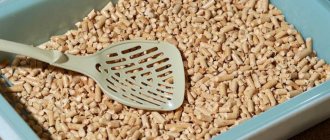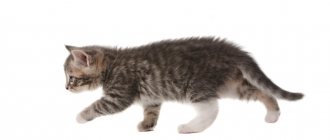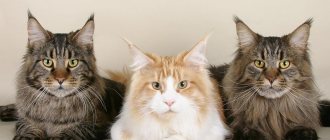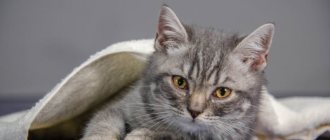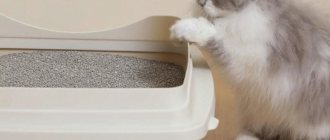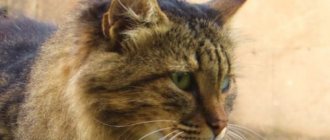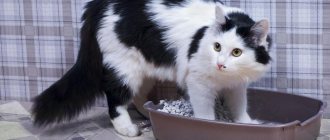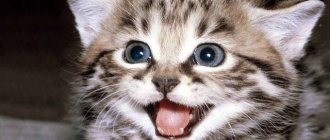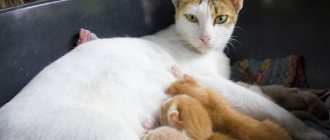What should be normal
The function of emptying the bladder and intestines is assessed using various indicators:
- First of all, frequency. “In a big way” a cat should go to the toilet at least 1 time a day (the lower limit of the norm is 1 time in 2 days), “in a small way” – 2-3 times a day. Anything less is constipation (in the case of a decrease in the frequency of bowel movements) and oliguria (a decrease in urine output).
- The second criterion for normality is painlessness. The act of defecation and urination should not be accompanied by pain. Pain in this process is not physiological.
- The third criterion is the absence of impurities in feces or urine. If a cat cannot pass a big bowel movement, but blood or mucus is released from the anus, this is a pathology. The same applies to blood in the urine.
Prevention: food for proper bowel function
Preventive procedures include:
- visit the veterinarian at least 2 times a year;
- active lifestyle of the pet and walks in the air;
- proper nutrition;
- Regular brushing of fur.
Owners of cats and kittens should remember that their pet should not be overfed. This is especially true for castrated animals. A special balanced diet has been developed for them.
What can you feed your cat if he is constipated?
To quickly restore the functioning of the digestive tract, the animal’s body must receive proteins and fiber. The diet does not include eggs, cheese or rice. These products aggravate the condition of the sick animal.
To improve intestinal function, it is recommended to give diluted store-bought condensed milk with water up to 3-4 times a day. Vaseline oil is given once a day on an empty stomach; for prolonged constipation, the dosage frequency is increased to 2-3 times.
Important! Only Vaseline oil can help with constipation in a cat. Oral use of sunflower, olive, and castor oil for therapeutic purposes is prohibited. These products are harmful to the animal's body.
Doesn't walk small
So, if a cat goes to the toilet “little by little” less than 2 times a day, the process is accompanied by pain, screaming or bleeding, then something is clearly wrong with the cat’s body. Let's take a closer look at this pathology.
Reasons for violating the regime
There are several reasons why the process of emptying the bladder may be disrupted:
- Dehydration. Insufficient fluid intake or increased loss of moisture from the body can lead to hypovolemia. Hypovolemia may be caused by blood loss. In this case, less blood is filtered by the kidneys and less urine is produced.
- Obstruction of the urinary tract (urolithiasis). In this condition, urine is formed normally, but due to obstruction it cannot be released.
- Inflammatory kidney diseases, renal failure. Damage to the glomeruli can also lead to oliguria and even anuria (complete absence of urine).
- Poor nutrition. Excessive consumption of salty foods can also lead to fluid retention in the body.
Something else interesting: Vitamin deficiency in cats
Signs of difficulty
It is not difficult for an attentive owner to identify pathology. The pet rarely goes to the toilet, and even if it does, very little urine is released. While emptying its bladder, your cat may scream or moan, which is a sign that urination is painful. In addition, sometimes blood can be detected in the tray. Often the condition is accompanied by intoxication syndrome, as toxic substances accumulate that are normally excreted by the kidneys.
Help your pet
In order to help your pet, you need to determine the cause of the illness. Most often, this cannot be done at home. Therefore, if you notice signs of urinary retention, you should contact your veterinarian. He will prescribe an additional examination (general and biochemical blood tests, ultrasound), which will help determine the diagnosis. After this, appropriate treatment is prescribed.
If you understand that the cause is most likely dehydration, then you need to restore your hydration. To do this, give your cat liquid often, but in small portions.
In other cases, specific treatment is necessary. For inflammatory diseases, antibiotics are prescribed, and sometimes it is necessary to use infusion therapy and diuretics. In case of obstruction, catheterization of the bladder is performed, since an overfilled bladder can rupture.
Can't go big
Let us examine in detail why constipation occurs in cats, what period is considered critical, what should be taken and preventive measures.
How many days can a cat go to the toilet without going to the toilet?
On average, an adult animal goes to the toilet once a day. However, if bowel movements occur once every 2-3 days, then this is not a critical condition for the animal. In this case, there is no need to sound the alarm.
But, if the duration of constipation exceeds the agreed period, then it is necessary to get an appointment with a veterinarian as soon as possible.
Mostly to the toilet
Treatment
Therapeutic measures for constipation directly depend on the cause of its occurrence, which will be determined by the veterinarian after an examination, for example, an ultrasound of the intestine. If constipation is caused by intestinal obstruction, then urgent surgical intervention is indicated. If constipation is caused by other reasons, then the specialist will give the cat an enema or prescribe laxatives: Vaseline oil, Duphalac, lacto- and bifidobacteria.
It is strictly forbidden to use castor oil. It can cause severe pain in the intestines, and you will never get a bowel movement.
Causes
The main causes of constipation are:
- improper diet;
- foreign body;
- helminthiasis;
- adhesive disease, hernia and gastrointestinal problems;
- accumulation of fur;
- neoplasms;
- inflammation of the anal glands;
- side effects of medications;
- psychological trauma (moving, change of owner).
Constipation is also quite often observed in older animals that are obese, lead a sedentary lifestyle and eat natural foods.
Symptoms
The main symptom of constipation is the absence of stool in the litter box. In addition, the animal exhibits the following symptoms:
- lethargy;
- lack of appetite;
- vomiting reflex;
- bloating;
- complaining sounds when trying to empty the bowels.
Sits in the tray
Prevention
The most important preventive measure is maintaining a proper diet. There must be sufficient fresh and clean water; it is also advisable to introduce fresh vegetables, wet food that enriches the intestinal flora, vitamin complexes, and bran into the diet.
Brush your cat periodically, especially for fluffy breeds. Control your activity, play more. Monitor the animal's weight. Give anthelmintic medications regularly.
Do not ignore your pet's litter box, as many pets do not want to go into a dirty litter box.
Complications
Intestinal dysfunction leads to an imbalance of opportunistic intestinal microflora, inflammatory processes in the intestinal mucosa, and poisoning of the body. But the most dangerous is considered to be cancer of the rectum and colon.
To summarize, we can say, no matter how much you love your furry friend, you should not forget that you need to closely monitor his health. If your cat cannot go to the toilet, you should not panic, but quickly bring him to the doctor for examination. Also, do not forget about preventive examinations that will help avoid most diseases.
Why is this happening
There may be several reasons for the development of this condition:
- Acute intestinal obstruction. May develop as a result of obstruction by a foreign body (hairball, swallowed bag or cord), intussusception.
- Tumor in the large intestine. The tumor can compress the intestinal lumen and prevent the passage of feces.
- Inflammatory bowel diseases.
- Pathology of the anus. Mechanical damage to the sphincter, such as scar deformity, can make bowel movements difficult.
- Dietary disorder. Insufficient fiber and water intake, and dry food can lead to excessive dryness of stool, which makes it difficult to pass.
Something else interesting: Vaccination of cats - is it necessary?
How to recognize difficulties
In order to recognize the pathology, it is enough to carefully monitor your pet:
- The cat goes to the toilet less than once every 2 days.
- During the act of defecation she experiences pain.
- An admixture of blood, pus or mucus is detected in the feces.
Animal treatment
You can help your pet only after discovering the cause. If the cause is scar deformity, tumor or intussusception, surgical intervention is necessary. If the condition is caused by poor nutrition, you need to reconsider your diet and add more fluid. For inflammatory diseases, antibiotics are prescribed. Symptomatic treatment is the prescription of laxatives, but these drugs can only be used after consulting a veterinarian.
Why doesn't my little kitten poop?
Kittens that are still under the “wing” of their mother are completely dependent on her in this delicate matter. Babies under one month old can poop normally only after the cat massages their tummy.
If such a baby does not go to the toilet for a long time, it means that the mother is not coping well with her responsibilities. This often happens to young, inexperienced cats “raising” their first litter. Causes of constipation in older kittens may include :
- severe stress due to weaning from mother and moving to a new place of residence;
- a sharp transition to a new type of diet (from milk to solid food);
- unsuitable food;
- congenital intestinal pathologies.
If quite a lot of time has passed since moving to a new home, and the baby still hasn’t gone to the toilet, and adjusting the diet does not help, most likely, the last of the listed points is occurring. The kitten should definitely be shown to a veterinarian. Serious treatment may be required, including surgery.
© shutterstock
Prevention measures
In order to prevent the development of a pathological condition, it is necessary to adhere to some rules:
- Provide the cat with sufficient drinking regime.
- Organize proper nutrition with sufficient fiber intake.
- Treat concomitant diseases of the intestines and genitourinary system in a timely manner.
- Vaccinate and deworm your pet.
- Avoid physical inactivity, play with your pet more often, and take walks.
In addition, you should carefully monitor the cat’s condition and contact a veterinarian at the slightest sign of pathology.
What should the owner do if the cat begins to shit?
If the cat marks and does not shit, we are looking for a solution to reduce his sexual activity or nervousness. In the first case, you can use special preparations, for example, “Cat Bayun”. In the second, by the way, it won’t hurt either. However, the main thing is to calm the pet down and convince him that no one is encroaching on his territory.
If a cat marks furniture and corners, there is no point in using odorous substances - the marking will become even more persistent in order to “kill” the alien, unpleasant smell. When the marks are associated with new furniture or renovations, you can generally just accept it and wait. After some time, everything will go back to normal. The new environment will acquire the smell of a cat - and the need for tags will disappear by itself. All that remains is to eliminate the cat urine stains and the pungent odor.
If the cat doesn’t poop in the litter box, but has chosen another place, we think what’s wrong with the litter box. If it is too small, replace it with a larger one. Dirty washing. We change the filler. We provide privacy and constant access. As an option, we place an additional tray in the place chosen by the cat.
If the cat is clearly “mischievous,” we establish relationships. We don’t scold, but we get demonstrably upset when we discover a “surprise”; women can cry, men just show how unpleasant it is for them. And then we call the cat, complain to him about the difficulties, pet him, talk, scratch him. And so on day after day. Until he begins to trust his owner again and stops doing things out of spite.
If “puddles and heaps” are found each time in different unpredictable places, things are bad. It is better to run to the veterinarian as soon as possible and have your pet thoroughly examined. After all, such behavior is completely uncharacteristic of cats, who are very neat and clean by nature. This means that health problems are very likely. And in this case, scolding the patient is not only pointless, but also cruel.
Veterinarian's priority actions
There are no ways to make a cat pee with acute urinary retention. Therefore, the first thing the veterinarian most often does is install a catheter for the animal. It is strictly prohibited to carry out such a procedure on your own, since incorrect placement of the catheter can cause serious complications.
Specialist help is needed
The procedure itself is quite painful, so it is performed under general anesthesia. After catheterization, the veterinarian performs a series of tests that will help determine what caused the pet's urinary retention.
The treatment method is selected after making a reliable diagnosis and assessing the general health of the pet. Depending on the nature of the disease, the cat may be prescribed antiseptics, antiviral, painkillers or diuretics. In some cases, hormonal and antihistamine medications are prescribed as additional medications.
To speed up the recovery process, the owner must strictly follow all the veterinarian’s recommendations and provide the animal with the most comfortable conditions.
Regardless of the diagnosis, cats that have problems with urination are always prescribed a special diet. Foods that increase the load on the kidneys and other organs of the urinary system should be excluded from the pet’s diet.
Industrial foods of the “economy” and “premium” classes are prohibited, since they contain a lot of salt, flavorings and preservatives that are harmful to the animal. It is allowed to give only medicated food of certain brands, designed specifically for pets with urological pathologies.
Medicinal food
If a cat has trouble going to the toilet, the following should be excluded from his diet:
- fatty meat – it makes urine denser;
- milk is a source of magnesium, which obstructs the outflow of urine;
- salt – promotes fluid retention;
- raw fish - contains phosphorus, which increases the likelihood of stone formation;
- raw meat - foods with a high protein content increase the load on the kidneys.
Until the animal’s condition improves, it is advisable that the basis of its diet should be high-calorie, but light foods that are easier to digest by the digestive system. In severe forms of the disease, most veterinarians advise feeding pets natural food.
Important! Catheterization is not only a painful, but also a dangerous procedure. If you use it too often, there is a risk of developing swelling of the urinary tract.
